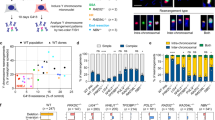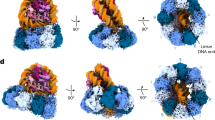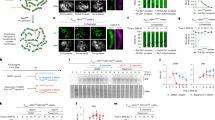Abstract
Holliday junctions can be formed during homology-dependent repair of DNA double-strand breaks, and their resolution is essential for chromosome segregation and generation of crossover products. The Mus81-Mms4 and Yen1 nucleases are required for mitotic crossovers between chromosome homologs in Saccharomyces cerevisiae; however, crossovers between dispersed repeats are still detected in their absence. Here we show that the Rad1-Rad10 nuclease promotes formation of crossover and noncrossover recombinants between ectopic sequences. Crossover products were not recovered from the mus81Δ rad1Δ yen1Δ triple mutant, indicating that all three nucleases participate in processing recombination intermediates that form between dispersed repeats. We suggest a new mechanism for crossovers that involves Rad1-Rad10 clipping and resolution of a single Holliday junction–containing intermediate by Mus81-Mms4 or Yen1 cleavage or by replication. Consistent with the model, we show accumulation of Rad1-dependent joint molecules in the mus81Δ yen1Δ mutant.
This is a preview of subscription content, access via your institution
Access options
Subscribe to this journal
Receive 12 print issues and online access
$259.00 per year
only $21.58 per issue
Buy this article
- Purchase on SpringerLink
- Instant access to full article PDF
Prices may be subject to local taxes which are calculated during checkout






Similar content being viewed by others
References
Krogh, B.O. & Symington, L.S. Recombination proteins in yeast. Annu. Rev. Genet. 38, 233–271 (2004).
Barbera, M.A. & Petes, T.D. Selection and analysis of spontaneous reciprocal mitotic cross-overs in Saccharomyces cerevisiae. Proc. Natl. Acad. Sci. USA 103, 12819–12824 (2006).
Chua, P. & Jinks-Robertson, S. Segregation of recombinant chromatids following mitotic crossing over in yeast. Genetics 129, 359–369 (1991).
Hagstrom, S.A. & Dryja, T.P. Mitotic recombination map of 13cen-13q14 derived from an investigation of loss of heterozygosity in retinoblastomas. Proc. Natl. Acad. Sci. USA 96, 2952–2957 (1999).
Bachrati, C.Z. & Hickson, I.D. RecQ helicases: suppressors of tumorigenesis and premature aging. Biochem. J. 374, 577–606 (2003).
Whitby, M.C. The FANCM family of DNA helicases/translocases. DNA Repair (Amst.) 9, 224–236 (2010).
Mimitou, E.P. & Symington, L.S. Nucleases and helicases take center stage in homologous recombination. Trends Biochem. Sci. 34, 264–272 (2009).
Szostak, J.W., Orr-Weaver, T.L., Rothstein, R.J. & Stahl, F.W. The double-strand-break repair model for recombination. Cell 33, 25–35 (1983).
Bzymek, M., Thayer, N.H., Oh, S.D., Kleckner, N. & Hunter, N. Double Holliday junctions are intermediates of DNA break repair. Nature 464, 937–941 (2010).
Collins, I. & Newlon, C.S. Meiosis-specific formation of joint DNA molecules containing sequences from homologous chromosomes. Cell 76, 65–75 (1994).
Schwacha, A. & Kleckner, N. Identification of joint molecules that form frequently between homologs but rarely between sister chromatids during yeast meiosis. Cell 76, 51–63 (1994).
Schwacha, A. & Kleckner, N. Identification of double Holliday junctions as intermediates in meiotic recombination. Cell 83, 783–791 (1995).
Ferguson, D.O. & Holloman, W.K. Recombinational repair of gaps in DNA is asymmetric in Ustilago maydis and can be explained by a migrating D-loop model. Proc. Natl. Acad. Sci. USA 93, 5419–5424 (1996).
Nassif, N., Penney, J., Pal, S., Engels, W.R. & Gloor, G.B. Efficient copying of nonhomologous sequences from ectopic sites via P-element-induced gap repair. Mol. Cell. Biol. 14, 1613–1625 (1994).
Bernstein, K.A., Gangloff, S. & Rothstein, R. The RecQ DNA helicases in DNA repair. Annu. Rev. Genet. 44, 393–417 (2010).
Wu, L. & Hickson, I.D. The Bloom's syndrome helicase suppresses crossing over during homologous recombination. Nature 426, 870–874 (2003).
Dayani, Y., Simchen, G. & Lichten, M. Meiotic recombination intermediates are resolved with minimal crossover formation during return-to-growth, an analogue of the mitotic cell cycle. PLoS Genet. 7, e1002083 (2011).
Cejka, P., Plank, J.L., Bachrati, C.Z., Hickson, I.D. & Kowalczykowski, S.C. Rmi1 stimulates decatenation of double Holliday junctions during dissolution by Sgs1-Top3. Nat. Struct. Mol. Biol. 17, 1377–1382 (2010).
Schwartz, E.K. & Heyer, W.D. Processing of joint molecule intermediates by structure-selective endonucleases during homologous recombination in eukaryotes. Chromosoma 120, 109–127 (2011).
Blanco, M.G., Matos, J., Rass, U., Ip, S.C. & West, S.C. Functional overlap between the structure-specific nucleases Yen1 and Mus81-Mms4 for DNA-damage repair in S. cerevisiae. DNA Repair (Amst.) 9, 394–402 (2010).
Muñoz-Galvan, S. et al. Distinct roles of Mus81, Yen1, Slx1-Slx4, and Rad1 nucleases in the repair of replication-born double-strand breaks by sister chromatid exchange. Mol. Cell. Biol. 32, 1592–1603 (2012).
Boddy, M.N. et al. Mus81-Eme1 are essential components of a Holliday junction resolvase. Cell 107, 537–548 (2001).
Ho, C.K., Mazon, G., Lam, A.F. & Symington, L.S. Mus81 and Yen1 promote reciprocal exchange during mitotic recombination to maintain genome integrity in budding yeast. Mol. Cell 40, 988–1000 (2010).
Ashton, T.M., Mankouri, H.W., Heidenblut, A., McHugh, P.J. & Hickson, I.D. Pathways for Holliday junction processing during homologous recombination in Saccharomyces cerevisiae. Mol. Cell. Biol. 31, 1921–1933 (2011).
De Muyt, A. et al. BLM helicase ortholog Sgs1 is a central regulator of meiotic recombination intermediate metabolism. Mol. Cell 46, 43–53 (2012).
Zakharyevich, K., Tang, S., Ma, Y. & Hunter, N. Delineation of joint molecule resolution pathways in meiosis identifies a crossover-specific resolvase. Cell 149, 334–347 (2012).
Agmon, N., Yovel, M., Harari, Y., Liefshitz, B. & Kupiec, M. The role of Holliday junction resolvases in the repair of spontaneous and induced DNA damage. Nucleic Acids Res. 39, 7009–7019 (2011).
Fagbemi, A.F., Orelli, B. & Scharer, O.D. Regulation of endonuclease activity in human nucleotide excision repair. DNA Repair (Amst.) 10, 722–729 (2011).
Sekelsky, J.J., McKim, K.S., Chin, G.M. & Hawley, R.S. The Drosophila meiotic recombination gene mei-9 encodes a homologue of the yeast excision repair protein Rad1. Genetics 141, 619–627 (1995).
Dowling, E.L., Maloney, D.H. & Fogel, S. Meiotic recombination and sporulation in repair-deficient strains of yeast. Genetics 109, 283–302 (1985).
Lyndaker, A.M. & Alani, E. A tale of tails: insights into the coordination of 3′ end processing during homologous recombination. Bioessays 31, 315–321 (2009).
Langston, L.D. & Symington, L.S. Opposing roles for DNA structure-specific proteins Rad1, Msh2, Msh3, and Sgs1 in yeast gene targeting. EMBO J. 24, 2214–2223 (2005).
Schiestl, R.H. & Prakash, S. RAD1, an excision repair gene of Saccharomyces cerevisiae, is also involved in recombination. Mol. Cell. Biol. 8, 3619–3626 (1988).
Niedernhofer, L.J. et al. The structure-specific endonuclease Ercc1-Xpf is required for targeted gene replacement in embryonic stem cells. EMBO J. 20, 6540–6549 (2001).
Bärtsch, S., Kang, L.E. & Symington, L.S. RAD51 is required for the repair of plasmid double-stranded DNA gaps from either plasmid or chromosomal templates. Mol. Cell. Biol. 20, 1194–1205 (2000).
Fishman-Lobell, J. & Haber, J.E. Removal of nonhomologous DNA ends in double-strand break recombination: the role of the yeast ultraviolet repair gene RAD1. Science 258, 480–484 (1992).
Symington, L.S., Kang, L.E. & Moreau, S. Alteration of gene conversion tract length and associated crossing over during plasmid gap repair in nuclease-deficient strains of Saccharomyces cerevisiae. Nucleic Acids Res. 28, 4649–4656 (2000).
Welz-Voegele, C. & Jinks-Robertson, S. Sequence divergence impedes crossover more than noncrossover events during mitotic gap repair in yeast. Genetics 179, 1251–1262 (2008).
Aylon, Y. & Kupiec, M. The checkpoint protein Rad24 of Saccharomyces cerevisiae is involved in processing double-strand break ends and in recombination partner choice. Mol. Cell. Biol. 23, 6585–6596 (2003).
Nicholson, A., Fabbri, R.M., Reeves, J.W. & Crouse, G.F. The effects of mismatch repair and RAD1 genes on interchromosomal crossover recombination in Saccharomyces cerevisiae. Genetics 173, 647–659 (2006).
Pâques, F. & Haber, J.E. Two pathways for removal of nonhomologous DNA ends during double-strand break repair in Saccharomyces cerevisiae. Mol. Cell. Biol. 17, 6765–6771 (1997).
Inbar, O., Liefshitz, B., Bitan, G. & Kupiec, M. The relationship between homology length and crossing over during the repair of a broken chromosome. J. Biol. Chem. 275, 30833–30838 (2000).
Roseaulin, L. et al. Mus81 is essential for sister chromatid recombination at broken replication forks. EMBO J. 27, 1378–1387 (2008).
Al-Minawi, A.Z., Saleh-Gohari, N. & Helleday, T. The ERCC1/XPF endonuclease is required for efficient single-strand annealing and gene conversion in mammalian cells. Nucleic Acids Res. 36, 1–9 (2008).
Osman, F., Dixon, J., Doe, C.L. & Whitby, M.C. Generating crossovers by resolution of nicked Holliday junctions: a role for Mus81-Eme1 in meiosis. Mol. Cell 12, 761–774 (2003).
Bastin-Shanower, S.A., Fricke, W.M., Mullen, J.R. & Brill, S.J. The mechanism of Mus81-Mms4 cleavage site selection distinguishes it from the homologous endonuclease Rad1-Rad10. Mol. Cell. Biol. 23, 3487–3496 (2003).
Ehmsen, K.T. & Heyer, W.D. A junction branch point adjacent to a DNA backbone nick directs substrate cleavage by Saccharomyces cerevisiae Mus81-Mms4. Nucleic Acids Res. 37, 2026–2036 (2009).
Mitchel, K., Zhang, H., Welz-Voegele, C. & Jinks-Robertson, S. Molecular structures of crossover and noncrossover intermediates during gap repair in yeast: implications for recombination. Mol. Cell 38, 211–222 (2010).
Ira, G., Malkova, A., Liberi, G., Foiani, M. & Haber, J.E. Srs2 and Sgs1-Top3 suppress crossovers during double-strand break repair in yeast. Cell 115, 401–411 (2003).
Orr-Weaver, T.L. & Szostak, J.W. Yeast recombination: the association between double-strand gap repair and crossing-over. Proc. Natl. Acad. Sci. USA 80, 4417–4421 (1983).
Tay, Y.D. & Wu, L. Overlapping roles for Yen1 and Mus81 in cellular Holliday junction processing. J. Biol. Chem. 285, 11427–11432 (2010).
Wardrope, L., Okely, E. & Leach, D. Resolution of joint molecules by RuvABC and RecG following cleavage of the Escherichia coli chromosome by EcoKI. PLoS ONE 4, e6542 (2009).
Sargent, R.G. et al. Recombination-dependent deletion formation in mammalian cells deficient in the nucleotide excision repair gene ERCC1. Proc. Natl. Acad. Sci. USA 94, 13122–13127 (1997).
Lupski, J.R. & Stankiewicz, P. Genomic disorders: molecular mechanisms for rearrangements and conveyed phenotypes. PLoS Genet. 1, e49 (2005).
Matos, J., Blanco, M.G., Maslen, S., Skehel, J.M. & West, S.C. Regulatory control of the resolution of DNA recombination intermediates during meiosis and mitosis. Cell 147, 158–172 (2011).
Aylon, Y., Liefshitz, B., Bitan-Banin, G. & Kupiec, M. Molecular dissection of mitotic recombination in the yeast Saccharomyces cerevisiae. Mol. Cell. Biol. 23, 1403–1417 (2003).
Hyppa, R.W. & Smith, G.R. Using Schizosaccharomyces pombe meiosis to analyze DNA recombination intermediates. Methods Mol. Biol. 557, 235–252 (2009).
Acknowledgements
This study was supported by grants from the US National Institute of General Medical Sciences of the National Institutes of Health under award numbers R01GM041784 and R01GM094386 to L.S.S., and from the Israeli Ministry of Science and Technology and the Israel Science Foundation to M.K.
Author information
Authors and Affiliations
Contributions
G.M., C.K.H., M.K. and L.S.S. designed experiments, and L.S.S. wrote the paper. Experiments in Figure 1 and Supplementary Figure 1 were carried out by A.F.L. and C.K.H., in Figures 2, 3 and 5, and Supplementary Figure 2 by G.M. and A.F.L., and in Figure 4 and Supplementary Figure 3 by G.M.
Corresponding author
Ethics declarations
Competing interests
The authors declare no competing financial interests.
Supplementary information
Supplementary Text and Figures
Supplementary Figures 1–6 and Supplementary Tables 1 and 2 (PDF 1722 kb)
Rights and permissions
About this article
Cite this article
Mazón, G., Lam, A., Ho, C. et al. The Rad1-Rad10 nuclease promotes chromosome translocations between dispersed repeats. Nat Struct Mol Biol 19, 964–971 (2012). https://doi.org/10.1038/nsmb.2359
Received:
Accepted:
Published:
Issue date:
DOI: https://doi.org/10.1038/nsmb.2359
This article is cited by
-
Slx5-Slx8 ubiquitin ligase targets active pools of the Yen1 nuclease to limit crossover formation
Nature Communications (2018)
-
Mus81-Mms4 and Yen1 resolve a novel anaphase bridge formed by noncanonical Holliday junctions
Nature Communications (2014)



